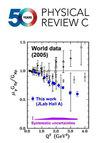Excitation of isobaric analog states from (p,n) and (He3,t) charge-exchange reactions within the G -matrix folding method
IF 3.4
2区 物理与天体物理
Q2 PHYSICS, NUCLEAR
引用次数: 0
Abstract
Differential cross sections of $(p,n)$ and $(^{3}\mathrm{He},t)$ charge-exchange reactions leading to the excitation of the isobaric analog state (IAS) of the target nucleus are calculated with the distorted wave Born approximation. The $G$-matrix double-folding method is employed to determine the nucleus-nucleus optical potential within the framework of the Lane model. $G$ matrices are obtained from a Brueckner-Hartree-Fock calculation using the Argonne Av18 nucleon-nucleon potential. Target densities have been taken from Skyrme-Hartree-Fock calculations which predict values for the neutron skin thickness of heavy nuclei compatible with current existing data. Calculations are compared with experimental data of the reactions $(p,n)\mathrm{IAS}$ on $^{14}\mathrm{C}$ at ${E}_{\mathrm{lab}}=135$ MeV and $^{48}\mathrm{Ca}$ at ${E}_{\mathrm{lab}}=134$ MeV and ${E}_{\mathrm{lab}}=160$ MeV, and $(^{3}\mathrm{He},t)\mathrm{IAS}$ on $^{58}\mathrm{Ni},$ $^{90}\mathrm{Zr},$ and $^{208}\mathrm{Pb}$ at ${E}_{\mathrm{lab}}=420$ MeV. Experimental results are well described without the necessity of any rescaling of the strength of the optical potential. A clear improvement in the description of the differential cross sections for the $(^{3}\mathrm{He},t)\mathrm{IAS}$ reactions on $^{58}\mathrm{Ni}$ and $^{90}\mathrm{Zr}$ targets is found when the neutron excess density is used to determine the transition densities. Our results show that the density and isospin dependences of the $G$ matrices play a non-negligible role in the description of the experimental data.g矩阵折叠法中(p,n)和(He3,t)电荷交换反应等压模拟态的激发
用畸变波玻恩近似计算了$(p,n)$和$(^{3}}{He},t)$引起靶核等压模拟态(IAS)激发的电荷交换反应的微分截面。采用$G$矩阵双折叠方法在Lane模型框架内确定核-核光势。$G$矩阵是由使用Argonne Av18核子-核子势的Brueckner-Hartree-Fock计算得到的。目标密度取自Skyrme-Hartree-Fock计算,该计算预测重核的中子表皮厚度值与现有数据相符。计算与实验数据的反应(p, n)美元\ mathrm {IAS} $, $ ^ {14} \ mathrm {C} $ $ {E} _ {\ mathrm{实验室}}= 135 $兆电子伏和$ ^ {48}\ mathrm {Ca} $ $ {E} _ {\ mathrm{实验室}}= 134 $兆电子伏和$ {E} _ {\ mathrm{实验室}}= 160美元兆电子伏,美元(^ {3}\ mathrm{他},t) \ mathrm {IAS} $, $ ^ {58} \ mathrm{倪},$ $ ^ {90}\ mathrm {Zr}, $和$ ^ {208}\ mathrm {Pb} $ $ {E} _ {\ mathrm{实验室}}= 420 $兆电子伏。实验结果得到了很好的描述,而不需要对光势的强度进行任何缩放。当用中子过剩密度来确定跃迁密度时,发现$(^{3}\ mathm {He},t)\ mathm {IAS}$在$^{58}\ mathm {Ni}$和$^{90}\ mathm {Zr}$目标上的反应微分截面的描述有了明显的改进。我们的结果表明,G矩阵的密度和同位旋依赖性在实验数据的描述中起着不可忽略的作用。
本文章由计算机程序翻译,如有差异,请以英文原文为准。
求助全文
约1分钟内获得全文
求助全文
来源期刊

Physical Review C
PHYSICS, NUCLEAR-
CiteScore
5.80
自引率
35.50%
发文量
863
期刊介绍:
Physical Review C (PRC) is a leading journal in theoretical and experimental nuclear physics, publishing more than two-thirds of the research literature in the field.
PRC covers experimental and theoretical results in all aspects of nuclear physics, including:
Nucleon-nucleon interaction, few-body systems
Nuclear structure
Nuclear reactions
Relativistic nuclear collisions
Hadronic physics and QCD
Electroweak interaction, symmetries
Nuclear astrophysics
 求助内容:
求助内容: 应助结果提醒方式:
应助结果提醒方式:


